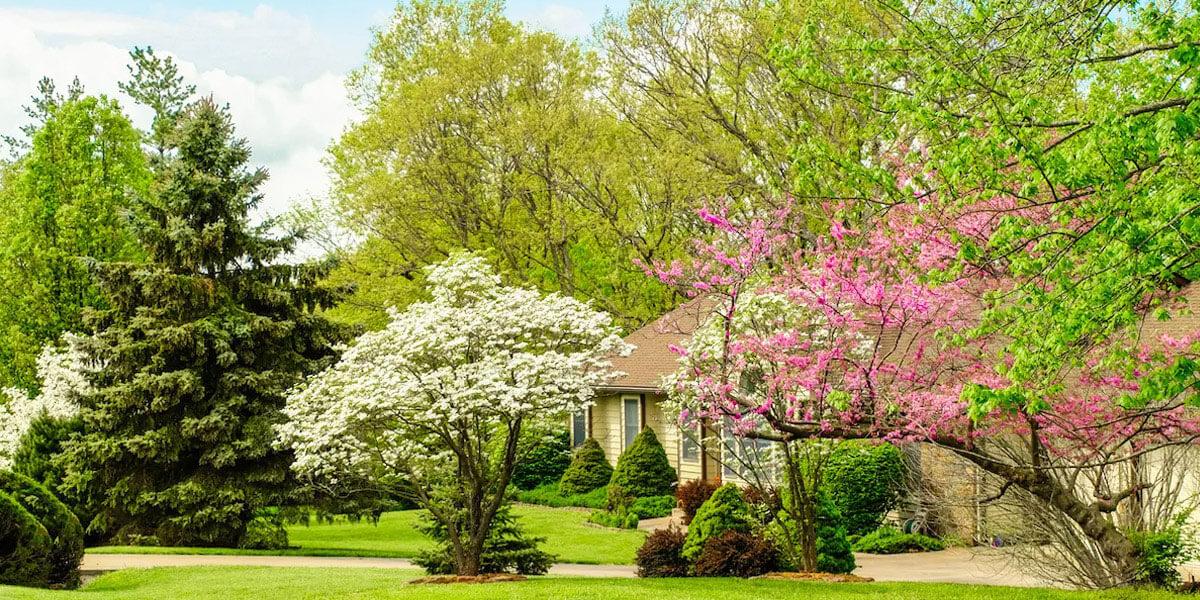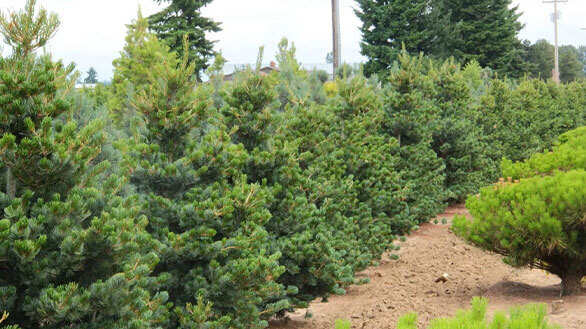
19 Jul What to Plant After a Tree Removal?
Tree removal can dramatically change your landscape, opening up opportunities for new planting and landscaping ideas. But what should you plant after a tree removal? Whether you’re looking to replace the removed tree or explore new landscaping options, it’s important to make informed decisions that will benefit your garden in the long run.
Related: Warning Signs Your Tree Should Be Removed
5 Best Trees to Plant After Removal
Choosing the right trees to plant after a tree removal can ensure that your landscape remains beautiful and healthy. We cover more about choosing your new tree in our article here.
Here are some excellent choices:
1. Dogwood Trees
Dogwood trees are great following a tree removal, since they are cherished for their stunning springtime blossoms.
These beautiful blooms range in color from white to pink and red. A dogwood’s foliage offers vibrant red and purple hues in the fall, making them a beautiful addition to any garden throughout the year.
These prefer well-drained, slightly acidic soil and partial shade but can adapt to full sun if adequately watered. Overall, these trees are relatively low-maintenance and can thrive in various soil conditions, making them an excellent choice for replanting after tree removal.
Additionally, they attract pollinators like butterflies and birds, enhancing the biodiversity of your garden.

2. Maple Trees
Maple trees are renowned for their brilliant fall foliage, with leaves that turn striking shades of red, orange, and yellow.
They are robust trees that can grow in a variety of soil types, from sandy to clayey, and they thrive in full sun to partial shade. Maples are also known for their sap, which can be tapped to make maple syrup.
These trees provide ample shade, which can help cool your home in the summer and reduce energy costs. Their dense canopy makes them ideal for creating privacy in your yard.
Maple trees can live for many decades, offering a long-term investment in your landscape. Learn how to plant and grow a maple here.

3. Birch Trees
Birch trees are known for their distinctive white bark that peels away in thin, papery layers, adding a unique visual interest to your garden.
They grow quickly, making them a good choice if you want to fill a space left by a removed tree promptly. Birch trees thrive in well-drained, slightly acidic soil and prefer cooler climates.
They require full sun to partial shade and regular watering, especially during dry spells. Birch trees are also beneficial for wildlife, providing habitat and food for various bird species.
Their graceful form and delicate leaves make them a lovely addition to any landscape.

4. Pine Trees
Planting pine trees is another way to improve your landscape following a tree removal. Pine trees are evergreen conifers that provide year-round greenery and can be a centerpiece in your landscape.
They are highly adaptable and can grow in various soil types, from sandy to heavy clay, and are drought-tolerant once established. Pines prefer full sun and are known for their long, needle-like leaves and cones, which add texture and interest to your garden.
They also serve as excellent windbreaks and can provide significant privacy. Pine trees can live for several decades, offering lasting beauty and environmental benefits, such as carbon sequestration and air purification.

5. Spruce Trees
Spruce trees are another type of evergreen that maintains its foliage throughout the year, providing consistent color and texture to your landscape.
They are known for their pyramid-like shape and dense needles, which can range in color from deep green to blue-green. Spruce trees thrive in well-drained soil and full sun but can tolerate some shade. They are hardy and can withstand cold temperatures, making them suitable for various climates.
Spruces are also popular as Christmas trees and can be decorated during the holiday season. Their dense branches provide excellent shelter for birds and small wildlife, enhancing the ecological value of your garden.

Related: How to Identify a Tree
3 Reasons Why You Should Plant After Tree Removal
Planting new trees or plants after a tree removal is not just about filling space; it has several benefits:
1. Soil Health & Erosion Control
Planting after tree removal is vital for maintaining and improving soil health. Trees and plants contribute to soil structure by their roots binding the soil particles together, which helps to prevent erosion. In areas with heavy rainfall or snowfall, this is particularly important as it reduces the risk of soil being washed or blown away. Additionally, tree roots create channels in the soil that improve drainage, allowing water to penetrate deeper and be absorbed more efficiently.
This helps prevent waterlogging and reduces surface runoff, which can carry away valuable topsoil and nutrients. By replanting, you are also restoring the organic matter in the soil as leaves and branches decompose, enriching the soil with essential nutrients that promote healthy plant growth.
2. Aesthetic Improvement
The removal of a tree can leave a noticeable gap in your landscape, which can be unsightly and disrupt the visual harmony of your garden. Planting new trees or plants can quickly fill this void and restore the aesthetic balance of your outdoor space. New plantings can introduce a variety of colors, textures, and forms that enhance the overall appearance of your garden.
Whether you choose a single specimen tree to create a focal point or a mix of shrubs and perennials to add depth and interest, replanting can transform a barren spot into a vibrant and attractive area. Furthermore, thoughtful landscaping can create a more inviting and pleasant environment for you and your guests to enjoy.
3. Increased Property Value
Trees and well-maintained landscapes significantly boost curb appeal, making your property more attractive to potential buyers. Mature trees and thoughtfully designed gardens provide a sense of stability and longevity, which can be appealing to homebuyers. In addition to their aesthetic value, trees offer practical benefits such as shade, which can reduce cooling costs in the summer, and windbreaks, which can lower heating costs in the winter.
These energy-saving benefits can be a strong selling point. A well-planted landscape also suggests that the property has been well cared for, which can give buyers confidence in the overall condition of the home. Investing in quality landscaping, including replanting after tree removal, can provide a substantial return on investment by increasing the market value of your property.

When to Replant After Tree Removal
Timing
The Gabe’s Tree Service team recommends to wait at least one year before replanting in the same spot where a tree was removed. This allows the soil to recover and reduces the risk of disease or pest issues.
Replanting the Same Tree
If you wish to replant the same type of tree that was removed, ensure it was removed with a root ball. Without the root ball, the tree will not be able to grow back. More on how to plant a tree here.
In Conclusion: What to Plant After a Tree Removal?
Planting after tree removal is a great way to rejuvenate your landscape and enhance your garden’s beauty and functionality. By selecting the right trees and plants and following proper planting guidelines, you can ensure a successful and thriving garden. More here on how to protect your tree once it’s planted.
Ready to plant new trees after removing old ones? Gabe’s Tree Service offers expert tree removal and tree-cutting services to prepare your landscape for further growth. Our certified arborists will remove unwanted trees and stumps, leaving your property clean and ready for planting. We serve the areas of Waupaca, Steven’s Point, Appleton, and Oshkosh, WI and the surrounding areas.
Contact us today to schedule your tree removal services and start enjoying a beautiful, healthy landscape.

